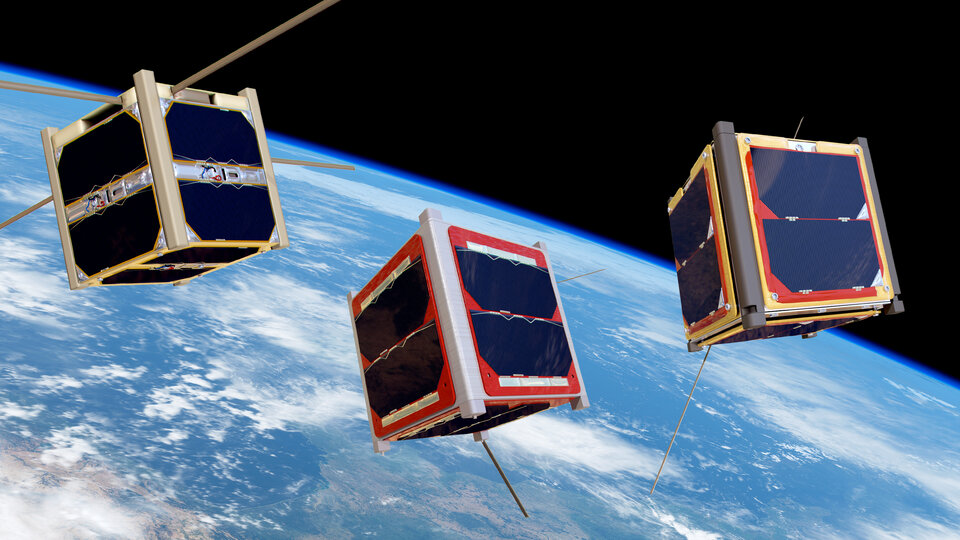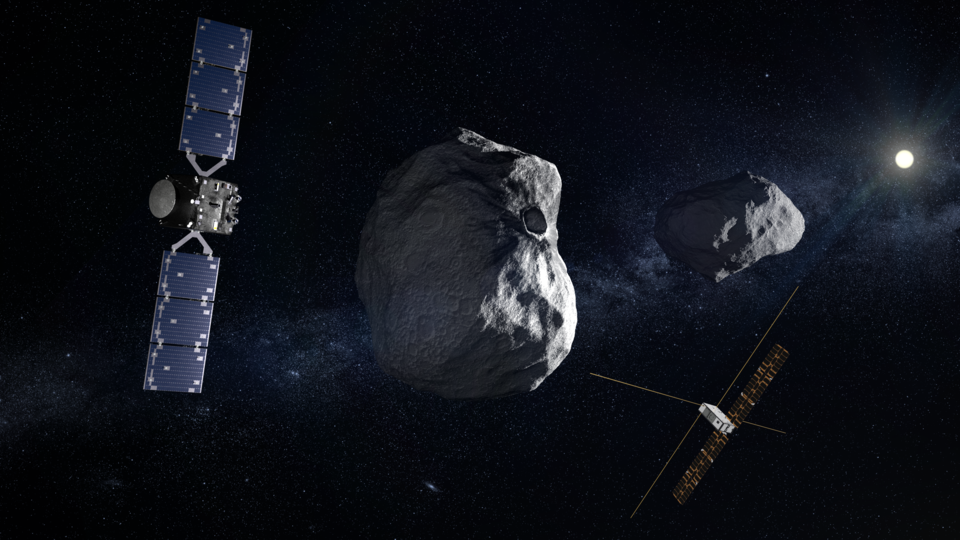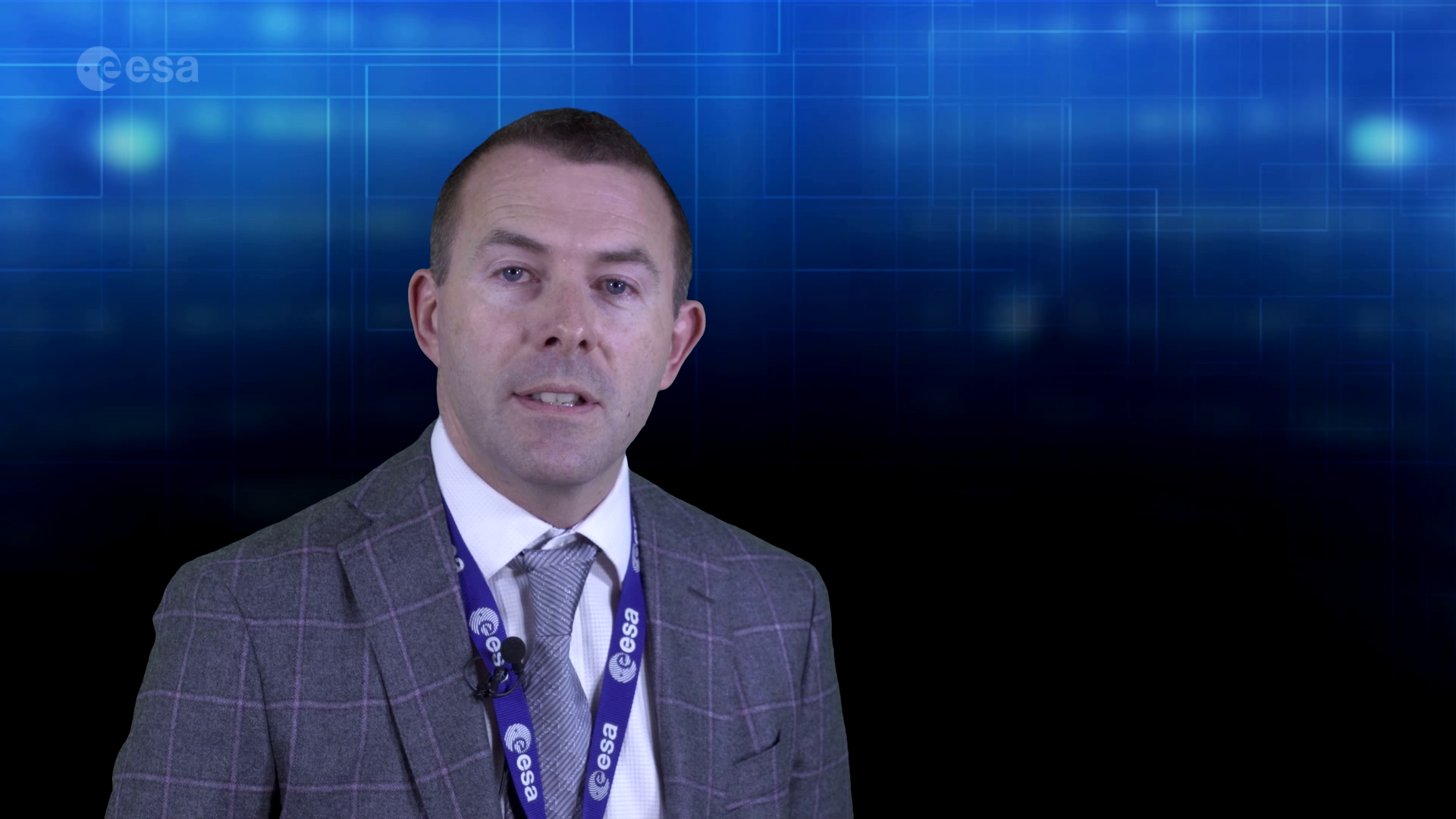CubeSats
We tend to think of satellites as huge spacecraft that tower over the engineers who build them. Consider Envisat, SOHO and GOCE – all ESA satellites similar in size to a small bus. But over the last 25 years, miniature satellites called CubeSats have been shaking up the space industry, making accessing space easier and cheaper for those who could previously only dream of it.
CubeSats are typically built up from standard cubic units each measuring 10 cm x 10 cm x 10 cm – just a bit bigger than a Rubik’s cube! The number of units depends on the CubeSat’s mission, but tends to be between 2 and 16, resulting in a mass of just 3–32 kg. These little satellites have a fraction of the mass, and cost, of more traditional satellites.
Having initially been developed as educational tools, CubeSats are increasingly being put to active use in orbit for technology demonstration, scientific studies, and even commercial purposes. And just like typical satellites, they are custom built to fulfil the specific requirements of their mission.

CubeSats tend to hitch a ride into space using extra space available on rockets, meaning lots of launch opportunities and low launch costs. They are packed in a standard-sized container which, at the push of a button, ejects them into space via a spring system. A similar technique is used to deploy CubeSats from the International Space Station (ISS), where they are launched out of the Japanese module, Kibo.
These small satellites provide affordable access to space for small companies, research institutes and universities. Their modular design means that subsystems are available off-the-shelf from different suppliers and can be stacked together according to the needs of the mission. This allows CubeSat projects to be readied for flight extremely quickly – typically within one or two years.
CubeSats are now commonly used in low-Earth orbit for applications such as remote sensing, space weather measurements and communications. But as engineers become more familiar with the technology, CubeSats are beginning to venture farther afield. Whether it’s to the Moon, Mars, or even further into deep space, these tiny spacecraft are certainly changing the game when it comes to low-cost space exploration.
Why is ESA interested in CubeSats?

ESA began giving university students the chance to develop their own space mission when it offered seven European universities the chance to have their CubeSat launched on the maiden flight of the Vega launcher in 2012. This was the precursor to the CubeSat education programme – Fly your Satellite! – which kicked off in 2013. Many Vega maiden flight and Fly your Satellite! Alumni have gone on to create their own companies that now form the basis of the CubeSat industry. CubeSats have clearly proven their worth as educational tools, but ESA is also using them for professional space missions.
Not only do CubeSats provide an affordable means of demonstrating exciting new technologies, they also drive the drastic miniaturisation of systems and encourage a new approach to spacecraft integration. But perhaps most exciting in terms of science, CubeSats bring versatility to space exploration that could help us find out lots more about Earth and the Solar System.
Discovery & Preparation activities

Under ESA’s Discovery & Preparation activities many CubeSat-focused studies have been funded and 'technology challenges' are regularly opened to get the most brilliant proposals for new space technology.
OPS-SAT: A flying laboratory, ESA’s OPS-SAT is the first of its kind. The 30-cm CubeSat packs a powerful onboard computer and an array of instruments that make it the ideal laboratory for testing innovative new technologies in space. In 2022, through Discovery ESA initiated 12 new experiments to do just that; they developed software, concepts and protocols that push the robust CubeSat to its limits and that could one day be essential parts of future spacecraft missions.
Hera: Due to launch in 2024, Hera is ESA’s contribution to the international Asteroid Impact and Assessment (AIDA) collaboration. NASA’s DART impactor already hit the moon of a binary asteroid system called Didymos, and Hera will check out the aftermath to study this type of asteroid deflection. Hera has three objectives: to demonstrate technology in interplanetary space, to investigate near-Earth object mitigation techniques, and to gain new insight into the evolution of the Solar System. Hera will be accompanied by two six-unit CubeSat explorers, giving European scientists their first chance to operate CubeSats in deep space.

Lunar CubeSats for Exploration (LUCE) Sysnova challenge: To support ESA’s lunar exploration ambitions, in 2017 ESA challenged European teams to design a CubeSat mission to the Moon. Two winners were selected – one to map meteoroid bombardments and the other to search for water ice and other volatiles at the lunar south pole. The winners worked with specialists via ESA’s Concurrent Design Facility (CDF) to develop their mission concepts further. The CubeSats would piggy-back on a launcher deploying a larger spacecraft on a trans-lunar injection or on a lunar transfer vehicle before being released into orbit around the Moon.
M-ARGO: Through the Fly element of the General Support Technology Programme, ESA is developing the Miniaturised Asteroid Remote Geophysical Observer (M-ARGO), a stand-alone deep space CubeSat to meet and characterise a near-Earth object. The M-ARGO concept was first explored in ESA’s CDF via a Discovery & Preparation study. Planned for launch in 2026+[NS1] , M-ARGO will test the potential of using miniaturised technologies to drastically lower the cost of space exploration by over an order of magnitude, thereby opening up a pathway for fleets of standalone CubeSats exploring objects in the inner Solar System, as well as making distributed measurements of space weather during solar storms.
Remote sensing with multiple cooperative nanosats Sysnova challenge: In 2014, ESA welcomed a team of scientists to design a project that would use cooperative nanosatellites for Earth Observation. This resulted in four different concept studies for missions designed to discover more about Earth using co-operative nanosatellites operating together in low-Earth orbit constellations.
As well as supporting these five CubeSat mission concepts, Discovery & Preparation has supported many studies that have explored specific CubeSat technologies, including investigating an anchoring device for CubeSat landers, looking into the feasibility of a multi-purpose satellite on board the International Space Station, analysing the impact of spacecraft tracking on the operation and design of small satellites, and investigating how increasing number of nano- and micro-satellites will affect impact risk in low-Earth orbit.
In 2023, Discovery & Preparation invited ideas for swarms of CubeSats that would work together to achieve more than any spacecraft operating alone. Seven promising mission concepts have been selected for study, with applications including Earth observation, telecommunications, astronomy, atmospheric science and space-based solar power transmission.
More Discovery & Preparation studies that have contributed to the future of CubeSats can be found here.
ESA-wide use of CubeSats


Access the video
Over the past ten years, ESA has been putting more time and effort into its CubeSat activities. Roger Walker, head of ESA’s CubeSat efforts, explains that “ESA is harnessing CubeSats as a fast, cheap method of testing promising European technologies in orbit”.
ESA’s first CubeSat project was GomX-3, a mission to demonstrate various signal monitoring technologies, which was deployed from the ISS in October 2015. Consisting of twin CubeSats, GomX-3’s successor GomX-4 monitored Arctic territory and tested radio links in space across distances of up to 4500 km. One of the twins also adjusted its orbit using cold-gas thrusters, opening up the prospect of rapidly deploying future constellations, maintaining their separations, and flying them in formations to perform new types of measurements from space.
GENA-OT is scheduled for launch in 2025 and will demonstrate numerous new technologies on a 16-unit CubeSat platform. It will use electric propulsion to compensate for atmospheric drag effects on the orbit altitude during the mission and a drag sail at end-of-mission for accelerated de-orbiting in line with ESA’s Zero Debris policy.

ESA’s Directorate of Telecommunications and Integrated Applications launched two CubeSats in 2019 under their Pioneer programme. The CubeSats are trialling novel telecommunications technologies and will be important for the next phase of Earth observation applications. Also in 2019, ESA’s Directorate of Operations launched OPS-SAT – an in-orbit testbed for innovative mission control software.
ESA’s Directorate of Earth Observation performed FSSCat/Phi-Sat-1, a double CubeSat mission for tandem observation of Earth’s polar regions also demonstrating AI onboard processing techniques of the image data. PhiSat-2 is currently in development in order to continue advancing these techniques. The Directorate of Navigation also opened up the opportunity to include CubeSats in its LEO-PNT project. Meanwhile, the Directorate of Human and Robotic Exploration is considering how CubeSats and small satellite missions can contribute to its exploration objectives.
Other completed, ongoing and planned ESA-funded CubeSat missions include:
- QARMAN – launched from the International Space Station in spring 2020, QARMAN aimed to demonstrate re-entry technologies, particularly novel heatshield materials, a new passive aerodynamic drag stabilisation system, and the transmission of telemetry data during re-entry via data relay satellites in low-Earth orbit.
- SIMBA – launched in September 2020, SIMBA measured the power of the Sun and the balance between incoming energy from the sun and the outgoing energy from Earth, as well as demonstrated a new integrated attitude determination & control subsystem.
- PICASSO – sent to space in the same launch as SIMBA, the CubeSat successfully measured the electron density in the ionosphere using a new Langmuir probe.
- RadCube –launched in 2021, RadCube successfully demonstrated miniaturised instrument technologies that monitor space weather, including an energetic particle flux telescope, and a miniaturised magnetometer deployed on the end of an 80-cm boom. A new CubeSat platform with enhanced redundancy avionics was also demonstrated.
- SunStorm – launched in 2021 with RadCube, SunStorm successfully demonstrated a solar X-ray flux monitor and measured flux spectra from several solar flares. An evolution of the monitor is now planned to be embarked on the NOAA SWFO-Next mission to Sun-Earth L2 for operational use.
- PRETTY – PRETTY will demonstrate a novel technique used primarily to detect sea ice and ocean surface properties at high accuracy using new GNSS reflectometry techniques, and test a miniaturised radiation dosimeter. It is due to launch on 5 October 2023.
What are other space agencies doing in this area?

NASA runs an extensive Small Spacecraft Technology Program as well as the CubeSat Launch Initiative. Previously selected CubeSats have studied near-Earth objects, space weather, Earth’s atmosphere and much more.
In 2018, NASA launched its first pair of CubeSats designed for deep space – Mars Cube One, or MarCO. Both satellites hitched a ride alongside InSight, NASA's latest Mars lander. The MarCO CubeSats followed InSight on its cruise through space; each relayed data back to Earth as the lander entered the Martian atmosphere.
In 2022, NASA launched a CubeSat mission to the Moon called CAPSTONE as a pathfinder for the Lunar Gateway, and the yeast-carrying BioSentinel mission to carry out the first deep space biology experiment. These were followed up in 2023 by a constellation of six CubeSats to study extreme tropical weather events. Once it can meet end-of-life deorbiting guidelines, another NASA CubeSat mission, GTOSat, will observe the forbidding radiation belts that circle Earth.

Currently, CubeSats are deployed from the ISS via the Japanese module, Kibo. The Japanese Space Agency has collaborated with the United Nations Office for Outer Space Affairs (UNOOSA) to set up KiboCUBE, a project that offers developing countries the opportunity to deploy their own CubeSats from the ISS.
The Canadian Space Agency runs the Canadian CubeSat Project which aims to engage students in real space missions, and in 2016 the Russian space agency developed the world’s first CubeSat to be produced entirely with a 3D printer, resulting in a stronger, lighter structure.
A 'PEEK' into the future

As a first test of a new printable, hard and electrically conductive plastic called PEEK, in 2017 ESA started 3D-printing CubeSat structures incorporating their own electrical lines. In 2020, PEEK was used to transmit a portrait of the Mona Lisa, marking the first step towards a future when plastic printed parts can incorporate their own power and data links within their built structures, instead of relying on separate wiring and circuits. In future, such miniature satellites could be ready to go once their instruments, circuit boards and solar panels are slotted in.
Last updated 27 September 2023.














 Germany
Germany
 Austria
Austria
 Belgium
Belgium
 Denmark
Denmark
 Spain
Spain
 Estonia
Estonia
 Finland
Finland
 France
France
 Greece
Greece
 Hungary
Hungary
 Ireland
Ireland
 Italy
Italy
 Luxembourg
Luxembourg
 Norway
Norway
 The Netherlands
The Netherlands
 Poland
Poland
 Portugal
Portugal
 Czechia
Czechia
 Romania
Romania
 United Kingdom
United Kingdom
 Slovenia
Slovenia
 Sweden
Sweden
 Switzerland
Switzerland



























